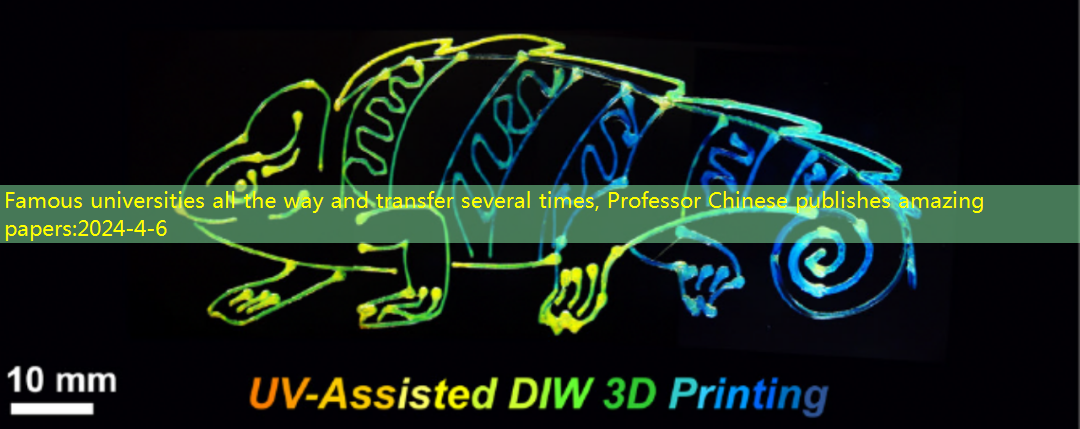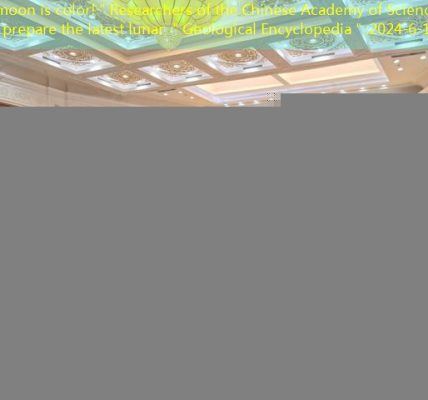Famous universities all the way and transfer several times, Professor Chinese publishes amazing papers
Diao Ying was born in the Gagdaqi district deeply in the forest and sea of Daxing’an Ridge -a “flying land” rarely heard of outsiders.
If time goes back, no one will think that this girl from remote mountainous areas will go all the way through Tsinghua University, Massachusetts Institute of Technology, and Stanford University until it becomes a professor of the Berberman Institute of the University of Illinois.Different majors such as pharmaceutical majors, flexible electronics research, and high -molecular self -assembly research have written their names in the top international academic journals.
Recently, Diao Ying published the latest research results in the National Academy of Sciences (PNAS): a new technology called “single, one ink 3D printing multiple colors”.
Foreign media reported that the picture was impressive when the results were reported: a cute little colorful dragon, from beginning to end, the color gradually changed from fluorescent yellow to green grass green, and then transitioned to the dazzling blue blue in the night sky.Just like Diao Ying’s own life trajectory, it is not only colorful and natural.
 Diao Ying’s team printed.Picture source: Diaoying team thesis “Direct-Ink-Write CrossLinkable BottBrush Block Polymers for on-Fly Control of Structural COLOR”
Diao Ying’s team printed.Picture source: Diaoying team thesis “Direct-Ink-Write CrossLinkable BottBrush Block Polymers for on-Fly Control of Structural COLOR”
Structural color lighter childhood dream
Diao Ying often went to the Museum of Natural History during his childhood to observe the gorgeous butterfly wings and his micro -structure under the microscope.She found that, unlike the color of clothing, pictures, flowers and plants, etc., the beauty of butterfly wings is particularly agile. In different light and different angles, different colors and luster will be shown.The so -called luminous color is probably describing such beauty.
After growing up, Diao Ying learned a term: structural color.The color we see in our eyes can be divided into two categories: chemical pigment and physical structure color.The color of the skin on the skin of peacock feathers, butterfly wings, and color -changing dragons is a typical representative of the structural color.Different from static chemical pigment colors (based on the selective absorption of molecular light), the structural color is produced by scattering, interference and diffraction between the physical structure of micr nano -nano -nano -nano -nano -nano -nano physical structure.Most things that can be “discolored” have structural colors.
Diao Ying was fascinated by the magical characteristics of the structure color, “studying the structure of structure is my dream from childhood.”
The papers published on PNAS this time were inspired by the color -changing dragon.
“The ink material we designed is the same as the color-changing dragon.” Diao Ying explained to the “China Science News” that the material is a co-solution (C-BBCP) of the bottle brush segment of light cross-linking, the surface is like the surface likeLike a bristles, a layered structure can be formed.
After squeezing this material as the ink from the 3D printed head, the structure in the ink will be self -assembled by evaporation drive, and the structure layer will continue to thicken.Different thickness structures will show different structural colors under white light.
If additional intervention is not performed, the ink evaporates from the solution to the solid state, and the color will appear from blue to red.If ultraviolet rays are introduced in this process for radiation, the color will be fixed.Diao Ying’s students also discovered by accident that the fixed color depends on the intensity of ultraviolet light.
After many tests, Diao Ying’s team improved and designed direct ink -writing 3D printing equipment with ultraviolet radiation capabilities based on this principle.In this way, by dynamically regulating UV light radiation in the process of 3D printing, a single color can be turned into a color spectrum.The color -changing dragon we saw was printed.
Effectively controlling three -dimensional printing at the micro level has always been a technical problem.The new technologies developed by Diao Ying’s team not only achieved the structure self -assembly control at nano -scale, but also achieved colorful structural color printing. It is a pioneering technology in the field of 3D printing.
What is more pleased is that this is also an environment -friendly “sustainable” technology.In her memories of her childhood, there is always a rolling black smoke and scent when coal burning in winter, so she has always hoped that through her own research, she can do its strength for environmental protection.
The polyophenyl ring structure in traditional chemical dyes can cause severe water pollution.Compared with dye colors, the structure of the structure does not rely on the polybenzene ring structure, which helps to achieve the sustainable development of related industries and reduce the cost of environmental protection.
The current technology only occurs during the printing process, and once the printing is completed, it can no longer change color.Diao Ying looks forward to continuing to develop more advanced structural color technologies, such as creating real discoloration materials.
“Think about it, you dragged your clothes, or bent down, changing the structure of the molecular assembly, and the color of the clothes will change. Will this affect fashion and aesthetics?”Combining color -changing materials with artificial intelligence technology, maybe we can also have clothing like a color -changing dragon, with the environment changing color clothing. “
Inspiration of brainstorms
The inspiration of this work was gathered with several colleagues and came out of the brain storm to apply for the US Natural Science Foundation.
At the University of Illinois, the concept of “attaching importance to team cooperation” penetrates into the bone marrow.”The school specially encourages everyone to gather together. More than a dozen or twenty teachers of different majors cooperate together to realize the very crazy idea, the idea of High Risk High Reward (high risk, high return).Many times, this idea can only be realized by people gather together, and no one can do it alone. “Diao Ying said excitedly.
This study was completed by 4 researchers.Damien GUIRENNET design materials; Diao Ying’s design and modification of 3D printing technology; Simon Rogers uses experimental measurement molecular assembly speed; Charles Sing explains the self -assembly mechanism by calculating the simulation molecular self -assembly process.
“It’s like the eight immortals cross the sea, each showing magical power -we cooperate together, not only invented new technologies, but also created new materials, put forward new mechanisms, and developed new ideas.” Diao Ying said proudly.
Diao Ying directed doctoral students.Interviewee confession
When asked what scientific research experience can be shared, Diao Ying blurted out: “Playfulness (fun)!”
“It’s just like a child playing outside. It is necessary to have such a spirit of free exploration and curiosity to discover a new phenomenon and have a new breakthrough.” She said.
“Freedom exploration” and “interest”, in a short interview, appeared many times in Diao Ying’s narration -not only describes her scientific research experience, but also wrote her attitude of life.
Colorful and changeable magical resume
Diao Ying’s academic career is impressive.
Her hometown is the Gagdaki district deep in the forest and sea of Daxing’an Ridge.It is located in the Olunchun Autonomous Banner, Hulunbuir, Inner Mongolia Autonomous Region, and is also affiliated to the Daxing’an Mountains in Heilongjiang Province. People have given this special human geographical phenomenon: “Flying Earth”.
Growing up in a remote hill, Diao Ying was not familiar with the outside world when he was a child.Until the middle school, Teacher Qu Anjun, who was very famous in the Daqing Iron Man Middle School, saw her grades and recruited her to participate in a physical competition.During the college entrance examination, she was admitted to the Department of Chemical Engineering from Tsinghua University from the Iron Man Middle School with excellent results.
From this moment, her life trajectory turned completely.
Diao Ying was very interested in mathematicalization, and this strong interest guided her to continue to explore on the academic road.
After graduating from Tsinghua University, she entered the Massachusetts Institute of Technology and received a doctorate degree here.At that time, she was studying pharmaceuticals, but during the blog, Bao Zhenan, a well -known Chinese female scientist and professor at Stanford University, came to MIT to give lectures.EssenceShortly after the lecture, Diao Ying contacted Professor Bao Zhenan and became a postdoctoral post -doctoral after interview.
“Teacher Bao accepted me across the field. She believes that my different perspectives can bring new ideas to flexible electronic topics.” Diao Ying recalled.
From chemical majors to pharmaceutical majors, to electronic flexible materials, Diao Ying’s life is still continuing.After entering the Berkeman Institute of Illinois, she devoted himself to the research of high -molecular self -assembly and printing.Frequent transformation of research has not become an obstacle to her research. In 2021, she was promoted to associate professor at the University of Illinois. In 2023, she also won the honorary title of “University Scholar” at the University of Illinois.
Such a resume is like those 3D printing works that change colorfully. Slimming and spiral rises, chasing your hobbies and dreams, and writing a gorgeous and bright life.
She smiled and said, “If you want to do it, things will be done; if you want to learn, you can learn.”





Recent Comments